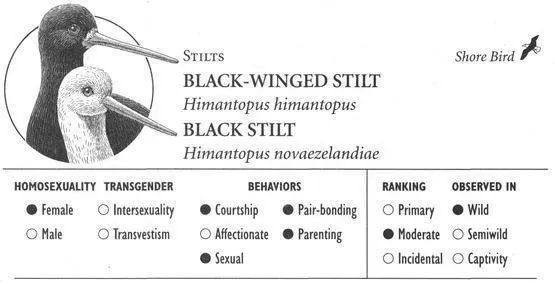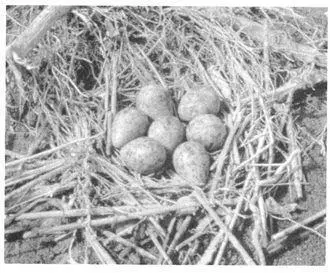Sources
*asterisked references discuss homosexuality/transgender
*Cramp, S., and K. E. L. Simmons (eds.) (1983) “Redshank (Tringa totanus).” In Handbook of the Birds of Europe, the Middle East, and North Africa, vol. 3, pp. 531—35. Oxford: Oxford University Press.
Garner, M. S. (1987) “Lesser Yellowlegs Attempting to Mate with Redshank.” British Birds 80:283.
Hakansson, G. (1978) “Incubating Redshank, Tringa totanus, Warming Young of Avocet, Avocetta recurvirostra.” Vår Fågelvårld 37:137—38.
*Hale, W. G. (1980) Waders. London: Collins.
*Hale, W. G., and R. P. Ashcroft (1983) “Studies of the Courtship Behavior of the Redshank Tringa totanus.” Ibis 125:3—23.
*———(1982) “Pair Formation and Pair Maintenance in the Redshank Tringa totanus.” Ibis 124:471—501.
*Nethersole-Thompson, D. (1975) Pine Crossbills: A Scottish Contribution. Berkhamsted: T. and A. D. Poyser.
*———(1951) The Greenshank. London: Collins.
*Nethersole-Thompson, D., and M. Nethersole-Thompson (1986) Waders: Their Breeding, Haunts, and Watchers. Calton: T. and A. D. Poyser.
*———(1979) Greenshanks. Vermillion, S.D.: Buteo Books.
Thompson, D. B. A., P. S. Thompson, and D. Nethersole-Thompson (1988) “Fidelity and Philopatry in Breeding Redshanks (Tringa totanus) and Greenshanks (T. nebularia).” In H. Ouellet, ed., Acta XIX Congressus Internationalis Ornithologici (Proceedings of the 19th International Ornithological Congress), 1986, Ottawa, vol. I, pp. 563—74. Ottawa: University of Ottawa Press.
———(1986) “Timing of Breeding and Breeding Performance in a Population of Greenshanks (Tringa nebularia).” Journal of Animal Ecology 55:181—99.

BLACK-WINGED STILT
IDENTIFICATION: A fairly large (12–15 inch) sandpiper-like bird with long pink legs, white plumage with black wings and back, and a slender black bill. DISTRIBUTION: Throughout much of Australasia, Europe, Africa, Central and South America, western and southern United States. HABITAT: Tropical and temperate wetlands. STUDY AREAS: Gyotuku Sanctuary, Ichikawa City, Japan; Morocco and the Belgium/Netherlands border area; subspecies H.h. himantopus.
BLACK STILT
IDENTIFICATION: Similar to Black-winged Stilt but with entirely black plumage. DISTRIBUTION: New Zealand; critically endangered. HABITAT: Rivers, lakes, swamps. STUDY AREA: Mackenzie Basin, South Island, New Zealand.
Social Organization
The primary social unit among Stilts is the monogamous mated pair; Black-winged couples often nest in loose colonies containing 2—50 families, while Black Stilts are less gregarious. Outside of the mating season, the birds gather in flocks of usually up to ten individuals, although assemblies of hundreds of Black-winged Stilts may also occur.
Description
Behavioral Expression: Lesbian pairs occur in both Black-winged and Black Stilts. In these partnerships, two females participate in courtship, copulation, and parenting activities together. Homosexual pairing and courtship in Black-winged Stilts often begins with a ritual NEST DISPLAY activity: each female takes turns symbolically “showing” the other a nest location by squatting on land as if she were incubating eggs, and making pecking motions in the mud as though she were turning the eggs over. Although heterosexual pairings also frequently commence with this activity, in lesbian pairs the two birds may spend considerably more time engaged in nest display. This may lead to full-scale courtship activities, such as DIBBLING—bill dipping and shaking by both partners, involving prominent splashing of water—and ritual preening, in which one female preens the side of her breast nearest to the other female, frequently combined with more splashing activity. Often one female takes up the NECK EXTENDED posture, a stylized pose in which she stands with her legs slightly apart and her neck lowered and extended just above the surface of the water. While one female is standing in this position, the other performs a courtship dance in which she moves back and forth behind her partner, striding in semicircles from one side to the other. The two females may participate in continuous courtship activities for up to three-quarters of an hour at a time. Sexual activity also takes place between members of a lesbian pair, with one female mounting the other as in heterosexual copulation.
Once bonded, the pair vigorously defends their territory against any intruding families and eventually builds a nest together. Because both females sometimes lay eggs, the nests of lesbian pairs often contain SUPERNORMAL CLUTCHES of 7–8 eggs, up to twice as many as those of heterosexual pairs (which usually have only 3–4 eggs). Both females take turns incubating the eggs; in heterosexual pairs the two birds also share incubation duties, but in many cases the female contributes a disproportionately greater amount of time than does the male. If the eggs are eaten by predators, the lesbian pair replaces them by laying a second clutch (as often happens with heterosexual parents as well). Most eggs laid by same-sex pairs are probably infertile. Like heterosexual pairs, some Black-winged Stilt lesbian pairs divorce. This may occur, for example, when one female forms a new pair-bond with another female. Although mate-switching may initially be accompanied by aggression between the separating females, the divorced partner sometimes still remains “friends” with the new pair, being allowed to visit their territory (unlike other birds, which are routinely chased away).
A nest with a “supernormal clutch” of eggs belonging to a pair of female Black-winged Stilts in Japan

Frequency: In Black-winged Stilts, female pairs may constitute anywhere from 5–17 percent of the total number of pairs (depending on the population), while about 2 percent of Black Stilt pairings are lesbian. Homosexual copulation occurs at fairly high rates in some Black-winged Stilt female pairs: in one case, two females were seen to mate with each other as often as five times in one day.
Orientation: Because the eggs they lay are usually infertile, it is likely that many female Black-winged Stilts in lesbian pairs are exclusively homosexual, i.e., they do not copulate with males (at least for the duration of their bond). In addition, some females show a persistent orientation toward other females, since they remate with another female if their lesbian partnership breaks up.
Nonreproductive and Alternative Heterosexualities
In addition to long-lasting monogamous pairs, a variety of alternative heterosexual family arrangements occur in Stilts. Black Stilts occasionally form trios of two females and one male (with both females laying eggs), while Black-winged Stilt pairs sometimes adopt chicks from other families and foster-parent them along with their own. Divorce and remating may occur in male-female pairs of Black-winged Stilts, and some males engage in courtship and copulation with females other than their mates. In Black Stilts, heterosexual pairs sometimes separate when their young fledge: the male often takes the juveniles with him as a single parent when he migrates, while the female remains behind. On returning, the male may get back together with his previous partner, or the female may find a new mate. In some intact Black Stilt families, fathers maybe abusive toward their young, behaving aggressively or rejecting their male offspring (although this has so far only been reported in captivity). In both of these Stilt species, individuals often masturbate by mounting an inanimate object (such as a piece of driftwood) and performing copulatory movements. In Black-winged Stilts this behavior may occur with extraordinary frequency—one bird was recorded making 20–30 such masturbatory mounts in one session, roughly once every 30 seconds. Finally, birds sometimes pair with individuals outside of their species: in some populations, about 30 percent of Black Stilts mate with Black-winged Stilts, and hybrids of the two species are common.
Читать дальше














